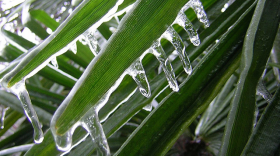That something good can be found in the most negative of situations is often described as a silver lining around dark storm clouds, but silver linings work underwater, too.
Expectations were somber for the health of Florida's Coral Reef and the Mote Marine Laboratory and Aquarium's four offshore coral nurseries in the Florida Keys this summer, as the ocean experienced record-shattering high temperatures just like on land due to the heat wave blanketing the world.
Mote scrambled six ships and 70 staff members to collect thousands of stressed and dying corals from its four offshore nurseries in the Florida Keys and move them all to four inland facilities.

Water temperatures were heating from warm to hot. With that, oxygen levels in the water were declining and salinities were increasing. In the midst of all the activity, Mote scientists decided to leave a few, specific coral species behind to see what would happen.
Thousands of other pieces of coral were moved to Mote's land-based coral nurseries on Summerland Key, Key Largo, Islamorada, and another in Sarasota. Among those saved were the endangered staghorn and elkhorn coral species.
The corals left behind were being put to the test by water that topped 100 degrees in the shallows. In water above 87 degrees, corals turn white, then are expected to die.
Summer ended, and with it the heat wave. Water temperatures slowly cooled in November and Mote began returning the rescued corals to the Florida Keys.

Mote divers checked on the corals sacrificed to science. Some not only survived. They thrived.
"These are ones we want to pay particular attention to as we look to the future of science-based coral reef restoration,” said Jason Spadaro, Mote’s coral reef restoration and research manager. “While this was incredibly devastating in a lot of ways, we’re finding silver linings."
Great coral recovery
Florida’s Coral Reef, which stretches nearly 350 miles from the Dry Tortugas up the Florida Keys to St. Lucie Inlet, was also dealing with the underwater heat wave. And there is no picking that up and moving it indoors.
When stressed, corals expel the colorful algae living inside its tissues, algae that provide corals with their colors and nourishment. With algae gone, the coral structure turns white. Called bleaching, it's a universal sign of corals in decline.

The high water temperatures this summer were due to a combination of ongoing human-caused global warming due to continued burning of fossil fuels, as well as a strong El Nino weather pattern — both are known to warm the oceans and the air.
Heat records nationwide were broken for weeks at a time. Asphalt in Phoenix got so hot it caused burns burns on people who touched it. Snowpack melted and nearly ended mega-droughts and lakes formed in in desert places like Death Valley.
There were heat-related deaths from coast-to-coast, deadly wildfires in Hawaii, and a Category 5 hurricane that hit Acapulco earlier this year.
Florida’s corals, it was thought, would be unable to handle it. So Mote's great coral recovery began in August.
"We were equipped with the land-based infrastructure to provide tens of thousands of corals a safe place to grow until conditions improve on the reef,” Michael Crosby, Mote's president said. “An evacuation this large, which to my knowledge has never been done before, (was) due to the sheer number of corals Mote has been able to produce."
Corralling corals
When Florida's Coral Reef was teeming with life living coral covered more than 30% of it. That coverage has dropped in just four decades to between 1% to 5%.
The return to sea of the corals, including reef-building brain, boulder, and star coral, will continue into early next year, an effort slowed by a requirement for a veterinarian health certification of all of the corals before they can be returned to offshore nurseries.
The corals are closely examined for any potential diseases or pests that could spread on the reef.
Once cleared and reintroduced to the offshore nurseries, the corals undergo another observation period before they are okayed to added to the Florida Coral Reef.
Things will then speed along due to a technique pioneered by Mote called microfragmentation, which is cutting the coral into small pieces to create genetically identical duplicates that grow as much as 50 times faster than a natural coral.

Mote plans to resume normal restoration activities early next year with a strategy now focused on using the robust coral genotypes. The work builds upon discoveries made by the University of Miami’s Rosenstiel School and Chicago’s Shedd Aquarium replicating deadly heating events on corals in shipboard tanks.
“These diverse and resilient corals will pass those traits on to the next generation of resilient corals on Florida’s Coral Reef,” Spadaro, Mote’s coral reef manager, said.
"We’re certainly glad this particular stress event is over, but we’re still in the process of collecting data and learning as much as we can from this event.”
Thanks to the test corals left behind, it turns out this event created a lot more learning to be done.
Environmental reporting for WGCU is funded in part by VoLo Foundation, a non-profit with a mission to accelerate change and global impact by supporting science-based climate solutions, enhancing education, and improving health.
Sign up for WGCU's monthly environmental newsletter, the Green Flash, today.
WGCU is your trusted source for news and information in Southwest Florida. We are a nonprofit public service, and your support is more critical than ever. Keep public media strong and donate now. Thank you.








